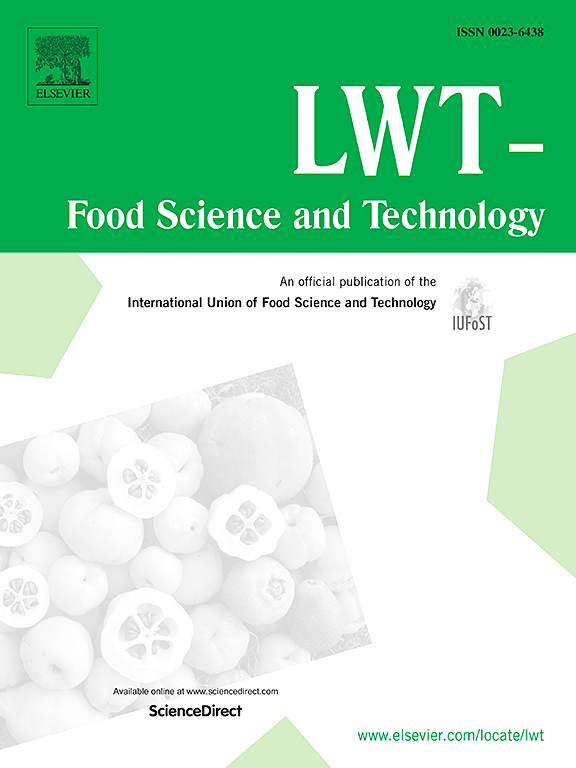白颊鲨皮明胶的酶水解:优化、结构转变、功能特性和抗氧化潜力
IF 6
1区 农林科学
Q1 FOOD SCIENCE & TECHNOLOGY
引用次数: 0
摘要
本研究探讨了利用阿尔卡拉酶酶解白颊鲨(Carcharhinus dussumieri)皮肤明胶以生产抗氧化肽的方法。采用响应面方法对酶-底物比(E/S)和水解时间进行了优化。在最佳条件下,E/S 为 4.8%,时间为 133 分钟,水解度(DH)最高,为 23.4%,DPPH 自由基清除活性(56.8%)和 FRAP 值(0.24 毫克 AAE/克)也最高。随后对水解明胶(WCSG-H)和非水解明胶(WCSG)进行的评估显示,它们的特性存在显著差异(p<0.05)。具体来说,凝胶电泳显示 WCSG 的分子量为 72-165 kDa,WCSG-H 的分子量为 8 kDa,而氨基酸分析表明两种样品中都含有大量的甘氨酸、脯氨酸和丙氨酸。ATR-FTIR 光谱显示,酶水解导致 WCSG 的二级结构更加紊乱。此外,WCSG 在乳液活性、发泡能力和泡沫稳定性方面都表现出更优越的性能,但在乳液稳定性方面的差异没有统计学意义(p>0.05)。相比之下,WCSG-H 的溶解度(97.7%)和抗氧化能力(56.8% 的 DPPH 自由基清除活性和 0.24 毫克 AAE/g 的 FRAP)明显高于 WCSG(分别为 85.22%、52.82% 和 0.08 毫克 AAE/g)。因此,这些研究结果表明,WCSG 和 WCSG-H 都是很有希望应用于功能食品的天然抗氧化剂。本文章由计算机程序翻译,如有差异,请以英文原文为准。
Enzymatic hydrolysis of white-cheek shark skin gelatin: Optimization, structural transformations, functional characteristics, and antioxidant potential
This study investigates the enzymatic hydrolysis of white-cheek shark (Carcharhinus dussumieri) skin gelatin using Alcalase to produce antioxidant peptides. Response surface methodology was employed to optimize enzyme-substrate ratio (E/S) and hydrolysis time. The optimal conditions, with an E/S of 4.8% for 133 min, achieved the highest degree of hydrolysis (DH) of 23.4%, as well as maximum DPPH radical scavenging activity (56.8%) and FRAP value (0.24 mg AAE/g). Subsequent evaluations of hydrolyzed (WCSG-H) and non-hydrolyzed gelatin (WCSG) revealed significant differences in their properties (p<0.05). Specifically, gel electrophoresis showed molecular weight fractions of 72–165 kDa for WCSG and <8 kDa for WCSG-H, while amino acid profiling indicated high levels of glycine, proline, and alanine in both samples. ATR-FTIR spectroscopy demonstrated that enzymatic hydrolysis led to a more disordered secondary structure in WCSG. Furthermore, WCSG exhibited superior emulsion activity, foaming capacity, and foam stability, though differences in emulsion stability were not statistically significant (p>0.05). In contrast, WCSG-H showed significantly higher solubility (97.7%) and antioxidant capacity (56.8% DPPH radical scavenging activity and FRAP of 0.24 mg AAE/g) compared to WCSG (85.22%, 52.82%, and 0.08 mg AAE/g, respectively). Therefore, these findings suggest that both WCSG and WCSG-H are promising natural antioxidants for functional food applications.
求助全文
通过发布文献求助,成功后即可免费获取论文全文。
去求助
来源期刊

LWT - Food Science and Technology
工程技术-食品科技
CiteScore
11.80
自引率
6.70%
发文量
1724
审稿时长
65 days
期刊介绍:
LWT - Food Science and Technology is an international journal that publishes innovative papers in the fields of food chemistry, biochemistry, microbiology, technology and nutrition. The work described should be innovative either in the approach or in the methods used. The significance of the results either for the science community or for the food industry must also be specified. Contributions written in English are welcomed in the form of review articles, short reviews, research papers, and research notes. Papers featuring animal trials and cell cultures are outside the scope of the journal and will not be considered for publication.
 求助内容:
求助内容: 应助结果提醒方式:
应助结果提醒方式:


